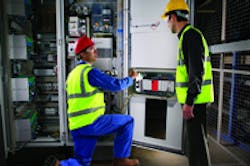A Closer Look at the Development of Safety Automation
Functional safety standards have improved the way contemporary safety systems are designed.
Historically, safety standards used principles based on redundancy, diversity, and diagnostics to create levels of safety system structures to help ensure the safety functions performed within a manufacturing environment; but no time factor was integrated into these standards.
A new approach to global standards adds a time element, known as “the probability of dangerous failure and the mean time to dangerous failure.” This adds confidence to system performance. ISO13849-1:2006 builds on the categories of safety structure; and IEC62061 builds on the foundation of the structure, also known as “hardware fault tolerance.” New diagnostics also offer a designer greater flexibility in achieving safety requirements. In combination these yield a time-sensitive level of integrity.
New standards demand that each safety system component have an assigned probability of dangerous failure or mean time to dangerous failure; as such, product design standards are being modified to define the criteria, testing requirements, and statistical tools used to determine parameters. Months of testing are required to confirm that a specific safety level is achieved.
The Changing Boundaries of Technology
The technologies that have integrated manufacturing control now coexist with safety control platforms. Further, high-integrity communications networks are now available, incorporating message redundancy, cross-checking, and stringent timing. This allows safety and standard systems to coexist on common media.
The ability to implement safety control within an architecture that can also perform multi-disciplined control tasks delivers significant benefits:
• Hardware, software, and support costs are minimized through asset sharing.
• Equipment productivity and lifespan are improved.
• Downtime is reduced.
In these more advanced systems, E-stops are wired into a safety input/output (I/O) block and connected via a safety capable network to the integrated safety automation system. Diagnostic information is provided to the controller and human-machine interface (HMI) in a readily accessible format; then, the controller, an operator, or a maintenance technician can take appropriate action.
Another technology advancement enabling these systems is seamless communication using open protocols. With the emergence of the common industrial protocol (CIP) safety standard, safety-rated devices can be connected to the same communications network as standard control devices. This standard improves the level of integration between standard and safety control functions—increasing visibility of safety in the system.
The combination of fast responding, local safety cells and the inter-cell routing of safety data create safety applications with faster response times. The greater flexibility also helps speed up system configuration, testing, and commissioning.
The CIP protocol can also integrate safety data with other plant information. As this data is made more readily available, the information system can provide management with information including diagnostic data, reasons for and frequency of demands on the safety system, statistical data for manufacturing improvements, production data, and security access.
Safety automation systems can now be fully integrated with the standard plant automation system, providing a powerful single platform to perform designed safety functions, meet standards, and efficiently operate the plant. These systems accommodate all machine lifecycle tasks including design, start-up, operation and maintenance—reducing costs and time to market, and improving performance.
Managing Risk
There is also increased industry support for proactive risk analysis.
The definition of formal risk analysis processes, covering risk identification, quantification, and mitigation, are now included in many international and regional standards such as ICE61508, ISO 13849, ANSI/B155.1 and RIA 15.08. Risk assessment processes defined within these standards typically have a lifecycle approach in sharing how to implement an effective process to identify machinery-related risks, as well as in quantifying the level of risk in terms of severity, frequency of exposure and avoidance.
Risk assessments provide processes for:
• Identifying specific hazards on a machine.
• Quantifying the risks that hazards present to employees.
• Evaluating practices that could help mitigate the risk.
In addition, the process specifies the most appropriate safety circuit architecture required to mitigate the initial risk rating determined by an assessment team.
Once the risks are fully defined and understood, they must be designed out or mitigated to the greatest extent possible. Risk mitigation measures the physical improvements done to the machine in order to reduce the potential of injury, environmental or property damage.
A formal risk assessment process also documents any identified risks, the protective measures and safeguards implemented to mitigate them, and the risk remaining after these methods have been deployed.
It is also important to provide appropriate training and supervision to ensure that operators understand safety measures, including proper used of personal protective equipment. Operators must be trained to operate the machines efficiently as they perform their tasks.
For more information, visit the Rockwell Automation Safety Solutions Portal.

